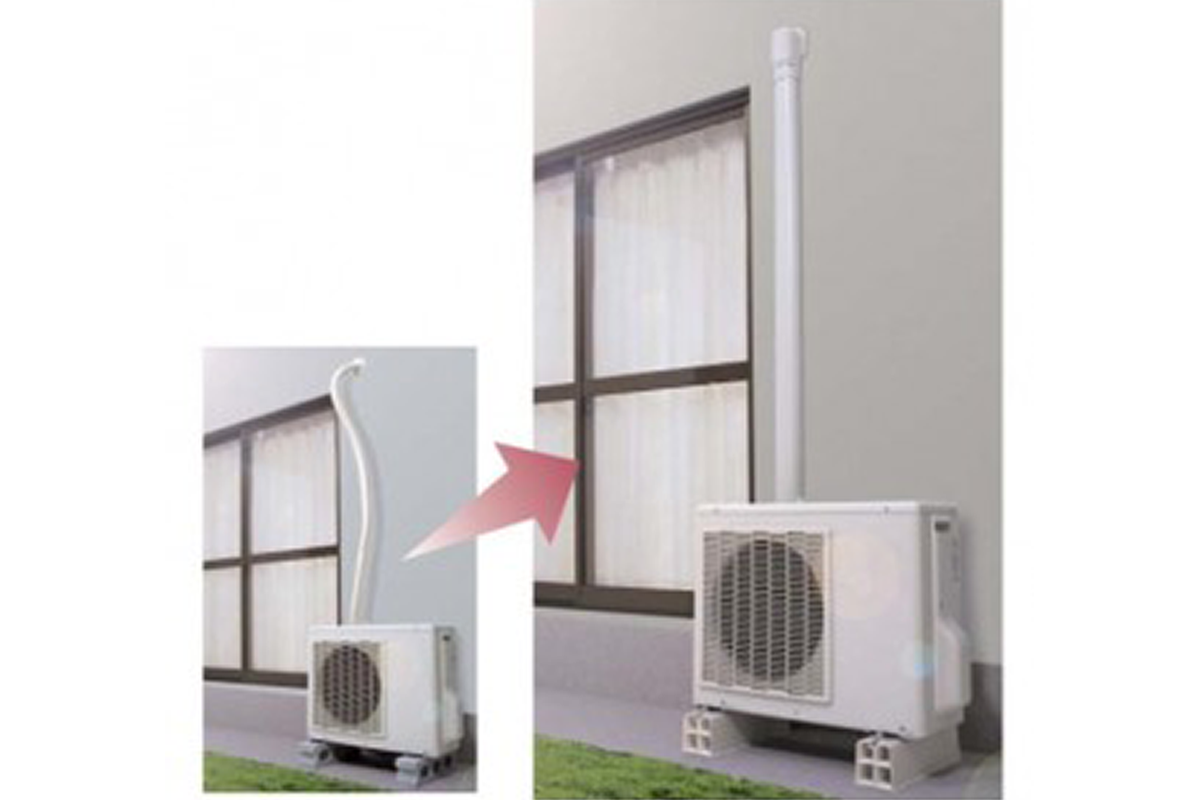Does piping need to be covered?
When installing an air conditioner in your home or office, many people may wonder whether to attach air conditioner piping cover trunking. It's an optional service and it costs an additional fee.
There are many advantages when it comes to having piping cover trunking, however it is not essential. There are some cases that we especially recommend installing it, but there are cases where the need for installation is low.
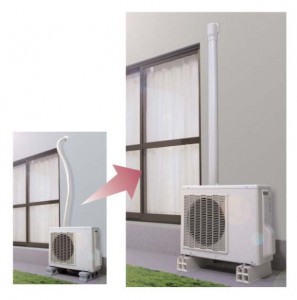
What if you don’t use piping cover trunking?
The "standard AC installation work" does not include piping cover trunking that covers the piping, and it is an optional feature for both indoor and outdoor AC units.
The piping that connects the indoor and outdoor units of the air conditioner is finished by a method called "tape winding". It's simple, but depending on the outside weather (rain, wind and UV rays) and environment, it will be damaged and worn out in a few years.
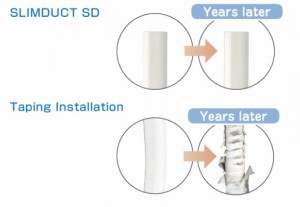
If want to prolong the life of your AC and don’t like exposed piping, you may want to install it.
Piping cover trunking can be used for both the indoor and outdoor units. Here we will explain the two major advantages of installing piping cover trunking.
By installing it on an outdoor AC unit, you can prevent deterioration of the air conditioner piping.
Especially if you plan to use the air conditioner for several years or more, there is a high possibility that it will deteriorate due to exposure to rain, wind and direct sunlight if you only use tape to cover the piping.
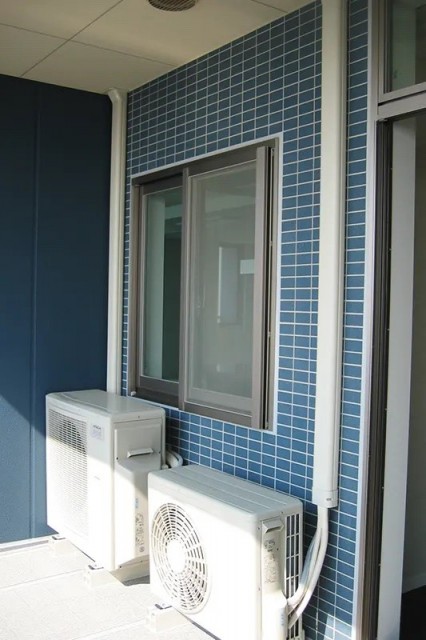
The advantages of installing it on the outdoor unit is to improve the appearance around the piping. By attaching piping cover trunking to hide the piping, the area around the air conditioner will look nice and neat.
On the other hand, it wouldn't be really necessary to install piping cover trunking if you already have a plan to replace or relocate the air conditioner. Another scenario is, when it’s possible to hide the hole in the wall behind the air conditioner indoor unit as well as the piping.
It is recommended that you carefully consider whether to have piping cover trunking when installing the air conditioner. This is because there are many cases where the cost is high when it comes to retrofitting work.
Differences between Indoor Unit piping cover trunking and Outdoor Unit piping cover trunking
In most cases, you will be charged for the optional installation of each piping cover trunking separately for the indoor and outdoor units of your air conditioning.
Here we will explain the difference between indoor piping cover trunking and outdoor piping cover trunking. First of all, indoor piping cover trunking covers the piping from the indoor unit installed on the wall to the place where the air conditioner piping passes.
Since the indoor plumbing is less likely to be deteriorated by UV rays, the advantage of attaching indoor piping cover trunking is to keep the plumbing together and make it look aesthetically pleasing.
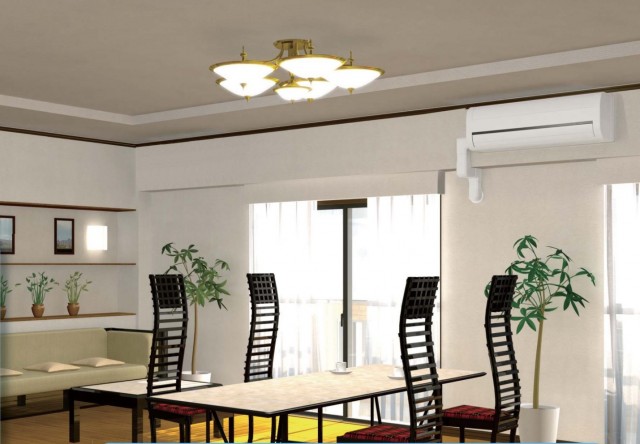
On the other hand, outdoor piping cover trunking covers the piping from the wall where the air conditioner piping passes to the outdoor unit. Basically, it is better to attach to the outdoor unit. As mentioned earlier, tape will quickly deteriorate due to weather and UV rays.
As the deterioration progresses, the pipes that were covered will be gradually exposed, and the heat insulating material that covers the refrigerant pipe will also deteriorate. If this happens, the air conditioner will not be able to fully function, if not stop working at all.
Therefore, it is best to install piping cover trunking to the outdoor unit
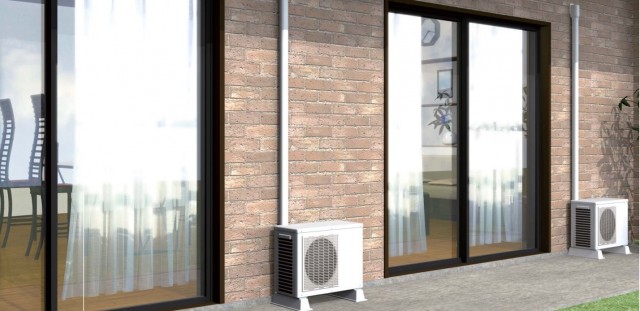
Similar to the advantages of installing piping cover trunking on the indoor units which was mentioned earlier, having piping cover trunking on the outdoor units can also improve the appearance of the exterior of your home.
If you don’t use piping cover trunking, you will have to opt to use another method called tape winding.
Let’s say you have a house with black exterior/walls. You decide to use tape winding instead of piping cover trunking.
If you are installing an air conditioner on the 2nd floor of the house without a balcony, the outdoor unit will be placed on the ground level. As for the air conditioner piping, it will be installed along the outer wall from the first floor to the second floor. Typically, the color of the tape is white, this means the piping will stand out against the black exterior which may not be aesthetically appealing.
However, if you use piping cover trunking instead of tape, you can choose the color of the piping cover trunking that matches the color of the exterior in order to improve the appearance. You will be able to conceal the piping and beautify the exterior of your home, as well as protect the piping from damage.
Types of piping cover trunking
Piping cover trunking - Slimduct SD
Slimduct SD series can be attached to apartments and homes. The purpose of using outdoor piping cover trunking is for better appearance and to prevent deterioration of the piping. The color can be matched to the color of the outer wall.
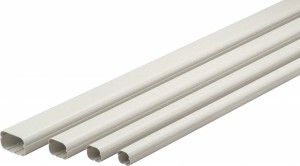
Can you attach piping cover trunking after installing the air conditioner?
Ideally, piping cover trunking should be attached at the same time as when installing the air conditioner, but it can also be attached later. It takes some time and effort to find a contractor to request installation and get a quote. However, the advantages of attaching piping cover trunking are great, so even if you have already installed an air conditioner, it could be worth considering it.
Although the retrofitting work itself can be done without any problem, the cost can be very high.
The cost of installing piping cover trunking to an existing air conditioner is higher than installing it to a new air conditioner. This is because when attaching piping cover trunking to an existing air conditioner, you may need to reinstall the air conditioner, in addition to the installation of piping cover trunking.
Since the air conditioner piping is fragile, you may call for professional installer to complete trunking installation perfectly because there is a risk of refrigerant gas leaking when it is lifted or bent.
Do I absolutely need to use piping cover trunking?
As mentioned here, there are so many advantages of installing piping cover trunking to your air conditioner at home. If you care about the exterior/interior of your home and you are seeking durability, and want to make sure your air conditioner runs at peak performance, its best to install piping cover trunking.
If you meet the two points below, you might only need to do a ‘’tape winding’’.
*1* You have plans to replace or move the air conditioner in the next few years.
Those who do not consider durability as a priority. Since durability is one of the major advantages of installing piping cover trunking instead of using tape. If you have plans to replace the air conditioner with a new model within a few years or you move frequently for any possible reasons such as work, you don’t necessary need piping cover trunking for your air conditioner.
*2* Not so particular about the interior and exterior of the house
Piping cover trunking can improve appearance and conceals the piping. if you don't mind the exposed look, then you can opt to use tape instead of piping cover trunking.
Fun facts and History of the Air Conditioner
The history of air conditioners is very old and can be traced back to BC. Since ancient times, there have been various ways for cooling the air, but since the invention of the air conditioner in 1902, air conditioners have rapidly evolved and have become a necessity in our everyday life.
Currently, the development of technology is underway to achieve both comfort and to tackle the issue that contributes to the growing global warming problem.
Let’s look at the history of air conditioners and how the technology has developed over the years.
The wisdom of our ancestors to create ‘’cool’’ air
Before air conditioners were invented to combat hot summer heat, there had been various ways and ideas for cooling and lowering the temperature of rooms and spaces.
Obviously, electricity was not available like it is today. Many people in those times had to rely on natural ways to cool the air.
For example, in ancient Egypt, water was sprinkled on windows to hang moistened reeds, and the heat of vaporization of water was used to cool the air blown through the windows. When the water evaporates, the heat of the surroundings is consumed and the temperature drops. This technique was very effective in dry desert climates.
In Persian culture, a tower named "Windcatcher" was installed to cool the entire building.
Windcatcher is a traditional Persian architectural element for creating natural ventilation in a building. Windcatchers remain in Iran and are also found in traditional Persian-influenced architecture in the Middle East, including the Arab countries of the Persian Gulf (mainly Bahrain and the United Arab Emirates), Pakistan and Afghanistan.
The central parts of Iran are a desert and is very dry with no moisture in the air. This means there is a large temperature difference between day and night. There is very little humidity, so the temperature can be very hot in the summer. Most buildings are made of very thick arched or brick walls that provide insulation and heat. This passive design strategy can absorb large daytime and nighttime temperature fluctuations and imperceptible average temperatures.
To warm up the room during the colder months, the thick walls allow the heat to accumulate during the day and move the heat waves towards the night when the outside air temperature is low.
In China, a rotary fan for air conditioning was invented by a technician in the late Han period. The rotary fan has seven wheels as large as 3 meters and it was operated by inmates manually moving and rotating the rotary fan.
In Japan, there has been a refrigeration facility called Himuro, which stores ice collected in winter, and ice was presented to the royal court in summer. The story of Genji, "Kagero," depicts women breaking the ice taken out of the ice house, wrapping it in paper, and putting it on their skin to cool off.
The development of air conditioning technology
Air conditioning was invented in the 20th century, but the development of its technology, which is the basis of air conditioning, began in the 17th century.
In the 17th century, Cornelis Drebbel, a Dutch inventor and alchemist famous for the invention of the submarine, succeeded in the experiment in the presence of King James I of England and Scotland, of "turning a room in midsummer into midwinter" by adding salt to ice.
The type of procedure Cornelis Drebbel used to achieve that outcome. However, American writer Tom Sharkman said that Cornelis Drebbel may have mixed water, salt, and potassium nitrate into ice crystals and sprinkled them in a room to cool them.
It has been said that King James I of England and Scotland trembled and escaped from the room because it was too cold to stay in the room.
In 1758, Benjamin Franklin, an inventor and a contributor to American independence, and John Hadley, a professor at Cambridge University and a chemist, conducted an experiment to rapidly cool an object using the heat of vaporization. They have succeeded in an experiment that can use the evaporation of highly volatile liquids such as alcohol and diethyl ether to lower the temperature of an object beyond the freezing point of water. Benjamin Franklin concludes that the result of this experiment "may be able to freeze a person to death on a hot summer day."
In 1842, Florida doctor John Gorrie made ice in a small steam engine to cool the air so that patients in a hospital in Apalachicola, Florida could spend their time comfortably. He eventually tried to cool the entire building with this ice machine, and eventually envisioned a spectacular air conditioning system that would cool the entire city.
John Gorrie, a doctor, scientist, inventor and humanitarian in the United States and is considered the father of cooling and air conditioning, obtained a patent for an ice machine in 1851 and embarked on mass production. However, the northern ice makers, who were profitable by transporting ice to the south, launched an opposition campaign against John Gorrie. They went around and promoted a negative campaign saying that artificially cooled air was "contrary to God's will". Because of that, John Golly received a backlash and the ice machine didn't sell at all and Gorrie died due to poverty in 1855.
In 1851, an ice maker and inventor, James Harrison from Australia, succeeded in developing a compressed ether refrigerator. This refrigerator is considered to be the world's first practical refrigerator, as it has become popular mainly in the beer and meat processing industries. At that time, there was no electricity, so this refrigerator was powered by coal gas.
This machine produced 3,000 kilograms of ice per day.
Advanced techniques and technologies for cooling the air were developed from the 17th century to the 19th century. As we learn the history of the air conditioner we love and use today, we can acknowledge that it was not developed overnight, and it was invented step by step by different inventors and what they found along the way.
Invention of the "air conditioner"
It was the American engineer Willis Carrier who actually invented and built the basis of the "air conditioner".
After graduating from college, Willis Carrier worked as an engineer at the Buffalo Forge Company, a company that manufactures commercial heaters. Willis Carrier’s client was a company called Sackett & Wilhelms Lithography and Printing Company in Brooklyn, New York. The company was known for its high-quality color printing, but the heat of the summer caused the humidity to rise abnormally, causing the color printing to swell and blur, which resulted in a decline in sales so they decided to reach out to Willis Carrier for help.
In 1902, Willis Carrier who was a 25-year-old engineer at the time, invented a primitive cooling system to reduce the humidity around the printing press. By sending air to the coil filled with coolant with an industrial fan to cool the air, making it possible to control the humidity around the printing press. It is said that this was the moment when the current air conditioner was born.
Around the same time, in 1906, Stuart Kramer, a textile engineer in Charlotte, North Carolina, was looking for ways to add moisture to the air at his textile factory. Stuart Kramer invented and patented a mechanism that combines moisture and ventilation to regulate the air in the factory. Taking from the meaning of “to condition” – “to improve something to the desired state” Stuart Kramer created the term "Air Conditioning".
Willis Carrier, who is now regarded as the father of refrigeration and air conditioning, thought at the time that this mechanism could control not only the humidity around the printing press but also the room temperature to make people in the room comfortable.
At the same time, he was also getting a large number of inquiries from companies. Carrier established ‘’Carrier Engineering Corporation’’ in 1915 and continued to improve its technology.
By 1922, Carrier developed a safer, smaller and more powerful centrifugal refrigeration compressor, and in 1933 developed a belt-driven condensing unit and air conditioner using a blower, mechanical control and steam coil to market the air cooling system market. It became a market model.
Air conditioners became known to the world at the 1939 New York World's Fair. As early as 1914, the introduction and usage of air conditioners was found in use at a private home. Generally speaking, air conditioners were completely unknown to the public. But in this era, the use of air conditioners was still limited to wealthy people who had shown interest in new innovations.
The facility where the first ever air conditioner was installed was in a 3D theater. People were surprised and very interested in the state-of-the-art experience of air conditioning.
By 1950, technological improvements had progressed, and the size of air conditioners had become smaller and smaller. Shortly after, the air conditioner market saw explosive growth in offices and homes.
【A match made in heaven: Air Conditioner & Piping Cover Trunking|INABA note vol.3】



